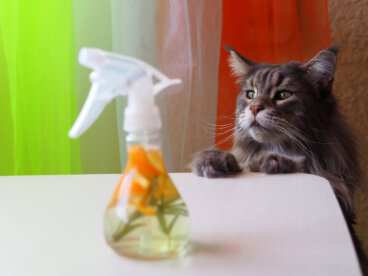Senile Dementia in Cats: Symptoms and Treatment

Over the years, pets begin to manifest changes in their behavior and health. Senile dementia in cats appears in older felines and reduces their understanding of the environment. In this article, we’ll tell you more about it.
What is senile dementia in cats?
Also called feline cognitive disorder, it’s a disorder that mainly affects cats over 15 years of age, although it can appear before (around 10 years of age).
Their capacity for understanding and cognition (learning) is affected due to their brain deteriorating. Since this disorder impairs the animal’s quality of life, it’s important to learn about this condition and what you should when your cat has it.
Some of the changes that the cat will experience are related to their behavior. It’s a misconception that senile dementia in cats makes them more aggressive or fierce. This condition is mainly related to their mental abilities. Cats with this condition tend to do things more slowly or not comply with certain pre-established “orders” like going to the bathroom in the litter box.
Symptoms of senile dementia in cats
A senior cat isn’t the same as a kitten, which is clear. However, when a feline is elderly, they notably modify their behavior and even some aspects of their personality. Some of the signs that alert the owners of senile dementia in cats are:
1. Confusion and disorientation
This is the most common symptom. The animal may walk strangely, move their head to the sides, stand for several minutes in one place, walk in circles around the house looking for something, not find their food bowl or litter box that has always been in the same place.

2. Changes in personal hygiene
One of the signs that a cat is healthy is when they groom continuously and look clean. If something is not right with a cat, they’re likely to stop cleaning themselves. The same thing happens when your pet is older because they “forget” to clean themselves, they seem more dirty and careless than usual.
3. Different behavior
Senile dementia in cats completely alters their habits and personality. They may ask for more attention than before, requiring pampering and caresses all the time or just the opposite: they could become more aggressive.
They can also spend more hours sleeping, especially at night. Keep in mind that a senior cat can rest between 16 and 18 hours a day, and lose interest in what surrounds them, even food or toys.
In turn, senile dementia causes the feline to make noise unexpectedly at night, as if in heat. In reality, what they are looking for is company and love. They may suffer a lot by staying alone and as when you arrive home they might not leave your side.

Treatments and care of senile dementia in cats
As a first step, you must know that the passage of time affects all living beings in one way or another and that there is no “cure” for senile dementia in cats. What you can do is delay the symptoms or prevent them from getting worse. Veterinarians may prescribe a pharmacological treatment that stops the cognitive decline, but it will not be completely eliminated.
What you can do is take care of your cat in the best way possible during their last years of life, even more than before. Here are some ideas that may be useful:
- Don’t move things from their place (both their objects and furniture)
- Take care of their hygiene (wipe them with a damp cloth to clean their coat)
- Play with them calmly and with a lot of patience
- Place ramps so they can go through certain environments
- Give food according to their age
Above all, we recommend that you give a lot of love and attention to your elderly pet. Remember that your love is what they need to move forward. Don’t leave them alone for several hours and, if that is not possible, when you return home, spend a lot of time showing them how much you love them.
Over the years, pets begin to manifest changes in their behavior and health. Senile dementia in cats appears in older felines and reduces their understanding of the environment. In this article, we’ll tell you more about it.
What is senile dementia in cats?
Also called feline cognitive disorder, it’s a disorder that mainly affects cats over 15 years of age, although it can appear before (around 10 years of age).
Their capacity for understanding and cognition (learning) is affected due to their brain deteriorating. Since this disorder impairs the animal’s quality of life, it’s important to learn about this condition and what you should when your cat has it.
Some of the changes that the cat will experience are related to their behavior. It’s a misconception that senile dementia in cats makes them more aggressive or fierce. This condition is mainly related to their mental abilities. Cats with this condition tend to do things more slowly or not comply with certain pre-established “orders” like going to the bathroom in the litter box.
Symptoms of senile dementia in cats
A senior cat isn’t the same as a kitten, which is clear. However, when a feline is elderly, they notably modify their behavior and even some aspects of their personality. Some of the signs that alert the owners of senile dementia in cats are:
1. Confusion and disorientation
This is the most common symptom. The animal may walk strangely, move their head to the sides, stand for several minutes in one place, walk in circles around the house looking for something, not find their food bowl or litter box that has always been in the same place.

2. Changes in personal hygiene
One of the signs that a cat is healthy is when they groom continuously and look clean. If something is not right with a cat, they’re likely to stop cleaning themselves. The same thing happens when your pet is older because they “forget” to clean themselves, they seem more dirty and careless than usual.
3. Different behavior
Senile dementia in cats completely alters their habits and personality. They may ask for more attention than before, requiring pampering and caresses all the time or just the opposite: they could become more aggressive.
They can also spend more hours sleeping, especially at night. Keep in mind that a senior cat can rest between 16 and 18 hours a day, and lose interest in what surrounds them, even food or toys.
In turn, senile dementia causes the feline to make noise unexpectedly at night, as if in heat. In reality, what they are looking for is company and love. They may suffer a lot by staying alone and as when you arrive home they might not leave your side.

Treatments and care of senile dementia in cats
As a first step, you must know that the passage of time affects all living beings in one way or another and that there is no “cure” for senile dementia in cats. What you can do is delay the symptoms or prevent them from getting worse. Veterinarians may prescribe a pharmacological treatment that stops the cognitive decline, but it will not be completely eliminated.
What you can do is take care of your cat in the best way possible during their last years of life, even more than before. Here are some ideas that may be useful:
- Don’t move things from their place (both their objects and furniture)
- Take care of their hygiene (wipe them with a damp cloth to clean their coat)
- Play with them calmly and with a lot of patience
- Place ramps so they can go through certain environments
- Give food according to their age
Above all, we recommend that you give a lot of love and attention to your elderly pet. Remember that your love is what they need to move forward. Don’t leave them alone for several hours and, if that is not possible, when you return home, spend a lot of time showing them how much you love them.
All cited sources were thoroughly reviewed by our team to ensure their quality, reliability, currency, and validity. The bibliography of this article was considered reliable and of academic or scientific accuracy.
Vite, C. H., & Head, E. (2014). Aging in the canine and feline brain. Veterinary Clinics of North America – Small Animal Practice. https://doi.org/10.1016/j.cvsm.2014.07.008
This text is provided for informational purposes only and does not replace consultation with a professional. If in doubt, consult your specialist.








